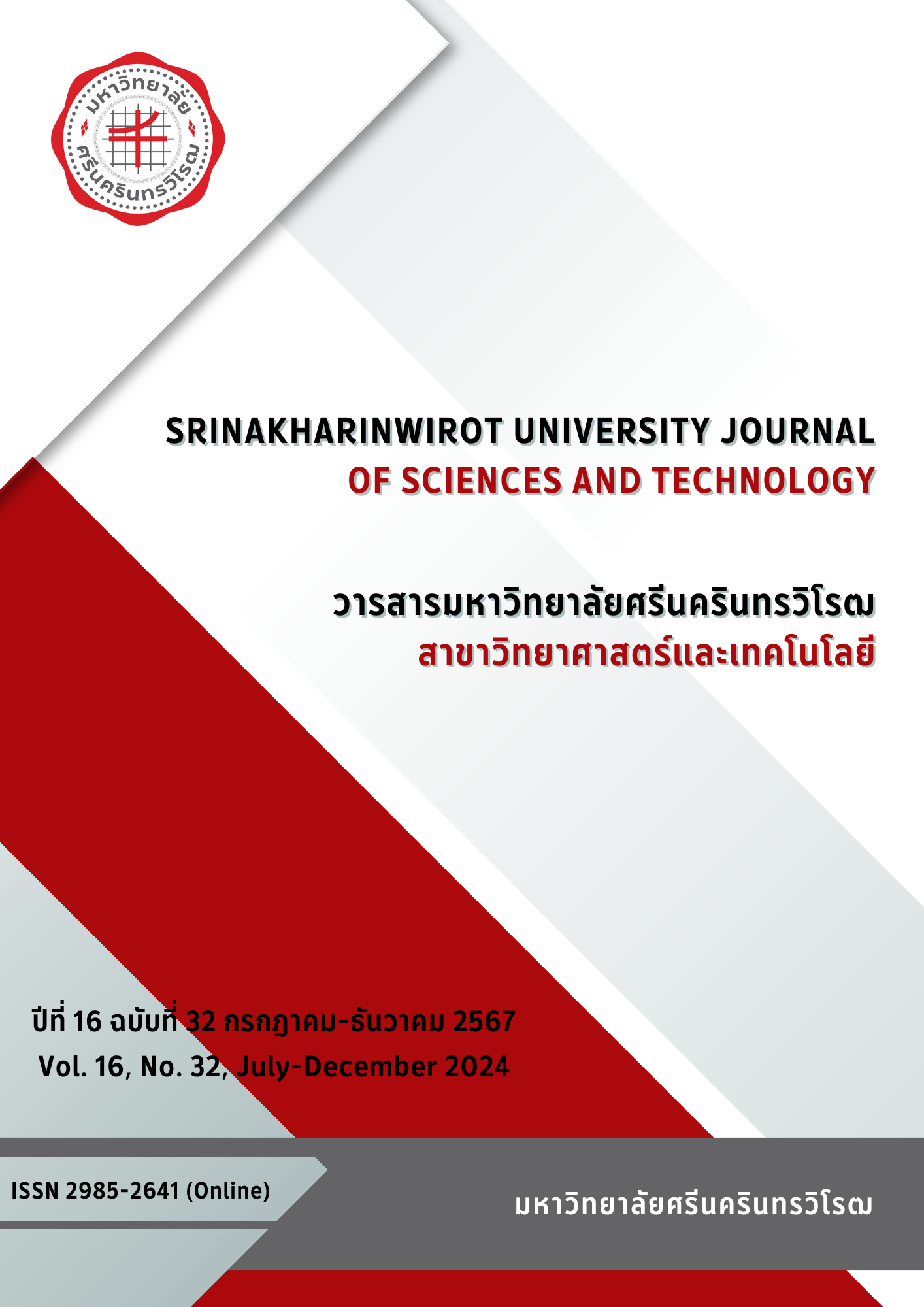CARBON STOCKS IN MANGROVE FORESTS AT MANGROVE FORESTS LEARNING AND DEVELOPMENT CENTER 2, NAKHON SI THAMMARAT
Keywords:
Carbon Accumulation, Mangrove Forest, Mangrove Plant SpeciesAbstract
The amount of carbon stored in mangrove forest plants studied at the 2nd Mangrove Forest Resource Development and Learning Center in Nakhon Si Thammarat. A total of 6 sampling plots of 20 x 50 m, Only the first sample obtained with this technique, then subsequent samples evenly spaced apart. Plant identification, counting, the process is recording the DBH (diameter at breast height), the height as well as for plant species list and plant family list of trees (DBH >4.5 cm and height >1.30 m). then calculated the biomass by using the allometric equation. According to the study's findings, there are 6 species and 5 families of trees in the mangrove plant community. Avicennia marina (Forsk) is the dominant tree with the highest value of importance index, followed by Rhizophora apiculata Blume, Lumnitzera racemosa Willd, with importance index values of 77.67, 76.36 and 62.04 percent, respectively. The large trees are typically 8.22±1.93 m in height and have an average diameter of 14.68±4.28 cm, A total of 18 rai of the mangrove forests around the Center for Learning and Development of Mangrove Forest Resources 2nd have an accumulation of biomass that is equal to 10,104.12 kg per rai, with an overall carbon accumulation of 85.48 tons, or 4.75 tons per rai.
Downloads
References
Donato, D. C., Kauffman, J. B., Murdiyarso, D., Kurnianto, S., Stidham, M., and Kanninen, M. (2011). Mangroves among the most carbon-rich forests in the tropics. Nature Geoscience, 4(5), 293-297.
Department of Marine and Coastal Resources. (2013). The Knowledge of mangrove. Handbook (6th ed.). Bangkok: Ployjean Media. Inc. (in Thai).
United Nations Environment Programme. (2023). Decades of mangrove forest change: What does it mean for nature, people and the climate? UNEP, Nairobi.
Department of Marine and Coastal Resources. (2020). Mangrove forest. https://km.dmcr.go.th/c_11/d_19697 (in Thai).
Department of Marine and Coastal Resources. (2018). Mangrove forest area in Nakhon Si Thammarat Province. https://www.dmcr.go.th/detailAll/24220/nws/141 (in Thai).
Rattanasiri, K. (2007). Manual of management of mangrove forest protection area and aquatic conservation. Bangkok: Mangrove Forest Resource Develovment Station 5 (Chonuri). Department of Marine and Coastal Resources. (in Thai).
Komiyama, A., and Ogino, K. (1987). Root biomass of a mangrove forest in southern Thailand. 1. estimation by the trench method and the zonal structure of root biomass. Journal of Tropical Ecology, 3, 97-108.
Intergovernmental Panel on Climate Change. (2008). 2006 IPCC Guidelines for national greenhouse gas inventories- A primer. In S. Eggelston, L. Buendia, K. Miwa, T. Ngara, and K. Tanabe (Eds). pp. 1-20. Institute for Global Environmental Strategies, Kanagawa: Japan.
Kutintara, U. (1999). Ecology fundamental basics in forestry. Department of Forest Biology, Faculty of Forestry, Kasetsart University, Bangkok (Thailand).
Sribut, S., Sunthornhao, P., and Diloksumpun, S. (2020). Valuation of carbon stock and utilization of non-timber forest products at the sirinart rajini ecosystem learning center. Thai Journal of Forestry, 39(2), 41-51. (in Thai).
Tomkham, N. (2018). Mangrove plant community and carbon sequestration: A case study of klong kone, muang district, samut songkram province [Unpublished master’s thesis]. Silpakorn University. (in Thai).
Meepol, W. (2010). Carbon sequestration of mangrove forests at ranong biosphere reserve. Journal of Forest Management, 4(7), 33-47. (in Thai).
Rakjarern, S., Sunthornhao, P., Suanpaka, W., and Meepol, W. (2017). Use value of mangrove forest and carbon stock in buffer zone of ranong biosphere reserve. Thai Journal of Forestry, 36(1), 58-67. (in Thai).
Downloads
Published
How to Cite
Issue
Section
License
Copyright (c) 2024 Srinakharinwirot University Journal of Sciences and Technology

This work is licensed under a Creative Commons Attribution-NonCommercial-NoDerivatives 4.0 International License.
Srinakharinwirot University Journal of Sciences and Technology is licensed Under a Creative Commons Attribution-NonCommercial-NoDerivs 4.0 International (CC-BY-NC-ND 4.0) License, Unless Otherwise Stated. Please Read Journal Policies Page for More Information on Open Access, Copyright and Permissions.



